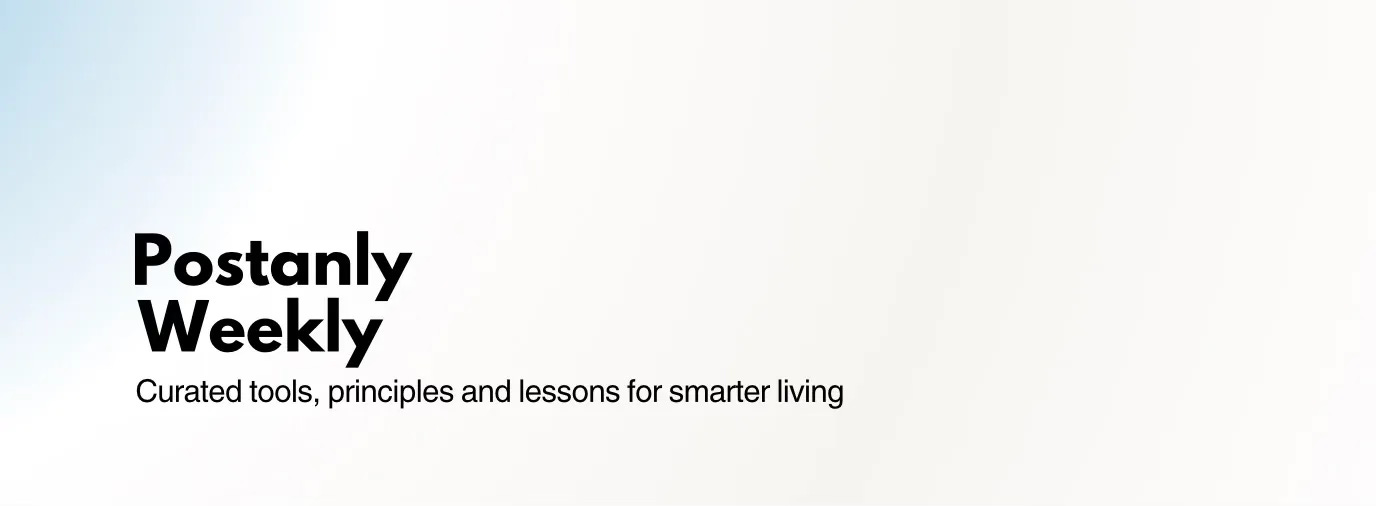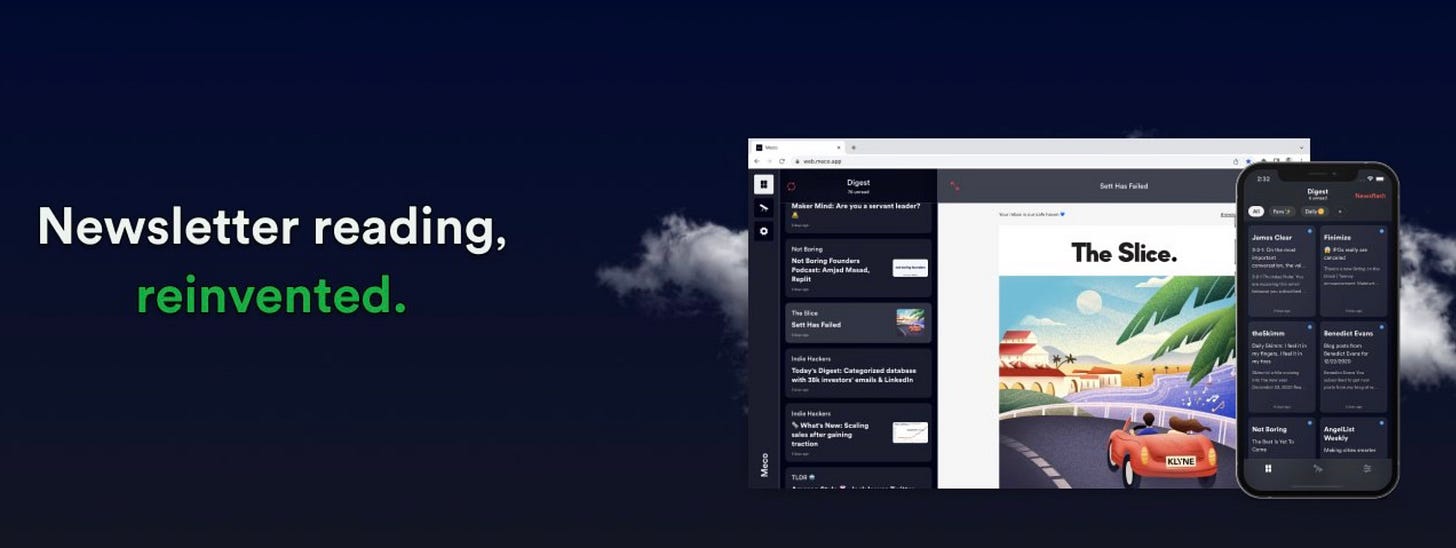Postanly Weekly is a reader-supported smarter living newsletter. To support my work, you can upgrade to a paid subscription for $7 per month or $40 for a year. With a modest contribution, you’re not only helping keep Postanly Weekly going, you also get free instant access access to Thinking Toolbox (mental models for life) and Mental Wealth Toolbox (practical concepts for smarter decisions).
In partnership with Meco
Meco is the perfect app if you read lots of newsletters. Declutter your inbox in seconds by using a newsletter aggregator built for reading. Your inbox wasn’t built for reading. Meco helps you move your newsletters to a space built for reading and declutter your reading experience in seconds.
Read all your awesome newsletters and Substacks on the app designed for reading. Get started, it’s free.
Life is full of choices—big and small. Algorithms help us make better ones. They’re step-by-step rules to get a result. We use them all the time, often without realising it. If you are your day. You decide what to do first. Most likely urgent but important task before the important but not urgent ones. That’s an algorithm.
When you budget your money, you follow a set of rules to save and spend wisely. That’s another one. Even choosing what to eat—balancing nutrition, taste, and time—follows a process. I use algorithms to simplify decisions. You do too. They help us manage time, money, and choices without overthinking.
From choosing the best route to work to meal planning, algorithms can help us optimise our routines and achieve our goals. They help us save time, reduce stress, and improve our physical and mental well-being. These are 36 algorithms that help me optimise life.
Optimal Stopping: Spend a certain amount of time exploring options before making a decision. After that point, you should decide based on the best option you have encountered so far.
Explore/Exploit: Balance exploring new options with exploiting the ones you already know to be good. Try new things but don’t abandon what has worked well for you in the past.
Sorting: Organise your environment in a way that makes it easy to find what you need. For example, you might sort your clothes by colour or books by author.
Bayes’ Rule: Update your beliefs based on new evidence. For example, if you find new information contradicting something you previously believed, adjust your beliefs accordingly.
Overfitting: Be wary of making decisions based on too much data or too many variables. Overfitting occurs when you make a decision based on a large amount of data that is not relevant to the decision at hand.
Game Theory: Consider the incentives and strategies of others when making decisions. For example, in a negotiation, you might consider the other person’s goals and motivations before making an offer.
Network Effects: Consider the impact of your decisions on others and the broader network. For example, if you decide to move to a new city, consider the impact on your family and social connections.
The HALT Method: Check in with yourself when making important decisions. HALT stands for Hungry, Angry, Lonely, Tired. You can make clearer and more informed decisions by recognising and addressing these feelings.
The Ikigai: A Japanese concept that refers to the intersection of what you love, what you’re good at, what the world needs, and what you can be paid for. You can create a fulfilling and meaningful life by identifying your purpose and passion.
The 10/10/10 Rule: Consider the impact of a decision in 10 minutes, 10 months, and 10 years. By evaluating a decision’s short-term and long-term consequences, you can make more informed and thoughtful choices.
The Stoic Philosophy: Focus on what you can control, accept what you can’t control, and live in accordance with nature. It’s a practice that can help you reduce stress, increase resilience, and find inner peace.
The Flow State: Find activities that bring you into a “ flow state,” where you are fully absorbed and engaged in what you’re doing. When you find and regularly engage in flow-inducing activities, you can improve your happiness and well-being.
The Eisenhower Matrix: Prioritise tasks based on urgency and importance. The matrix is divided into four quadrants: urgent and important, not urgent but important, urgent but not important, and not urgent or important. Organising tasks into these quadrants allows you to prioritise your time and focus on what matters most.
The ABC Method: Prioritise tasks based on their difficulty level. “A” tasks are the most important and difficult, while “C” tasks are less important and can be done later. Once you recognise the most difficult tasks, you can make progress and build momentum.
The Four Agreements: This algorithm suggests living by four principles — be impeccable with your word, don’t take anything personally, don’t make assumptions, and always do your best.
The Pomodoro Technique: Break your work into focused, 25-minute intervals followed by a short break. It can help you stay productive and avoid burnout.
The 80/20 Rule (Pareto Principle): 80% of the effects come from 20% of the causes. For example, 80% of your results come from 20% of your efforts. It can help you focus on the most important tasks or areas of your life.
The Pareto Principle for Social Life: 80% of your social interactions come from 20% of your acquaintances. By focusing your social efforts on the most meaningful relationships, you can optimise your social life and build deeper connections.
The Rule of Three: Limit your to-do list to three items per day. By focusing on a small number of tasks, you can prioritise what’s most essential and avoid feeling overwhelmed.
The Two-Minute Rule: If a task can be completed in two minutes or less, you should do it right away. It can help you avoid procrastination and tackle small tasks quickly.
Overthinking Breeds Indecision: By all means, find good options to ponder, but aim to make a decision based on the best option you have encountered so far.
The GOOP Method: Set a Goal, identify the Outcome, anticipate potential Obstacles, and develop a Plan for achieving your goal. It can help you clarify your goals and create a plan for achieving them.
The 5-Second Rule: If you have an impulse to do something (e.g. exercise, make a phone call, start a project), you should act on it within five seconds. It can help you overcome self-doubt and take action towards your goals.
The Morning Routine: Establish a consistent morning routine to start your day on the right foot. It could include activities like meditation, exercise, journaling, or planning your day.
The Gratitude Practice: Cultivate a regular gratitude practice to focus on the positive aspects of your life. Consider writing down three things you’re grateful for each day or expressing gratitude to others.
The Law of Diminishing Returns: There is a point of diminishing returnsin everything, including work. Your productivity and effectiveness will decrease over time as you work longer on a task. It’s important to take breaks, rest, and recharge to maintain peak performance.
The Power of Habit: Habits play a significant role in our daily lives. Small, consistent changes can have a big impact over time. You can improve your overall quality of life by identifying and changing negative habits and building positive habits.
The Growth Mindset: Adopting a growth mindset by focusing on learning and improvement can lead to greater success and fulfilment. You can develop a growth mindset and achieve your goals by embracing challenges, learning from failure, and persisting through obstacles.
The Sunk Cost Fallacy: The tendency to continue investing time, money, or resources into a project or decision because of the resources already invested, even when it is no longer logical or beneficial. Learn to recognise when a decision is no longer working, be willing to cut your losses, and move on.
The One Thing: Focus on the most important task or priority for the day, and give it your full attention and effort until it is complete. You can achieve more with less effort by narrowing your focus and eliminating distractions.
The 5-Minute Rule: This algorithm suggests that when faced with an unpleasant or daunting task, commit to doing it for just 5 minutes. Once you get started, you’ll find it easier to continue and complete the task.
The Power of No: Learn to say “no” to requests and commitments that do not align with your values or priorities. It can free up time and energy to focus on what truly matters to you.
The 20-Second Rule: Make it 20 seconds easier to start a positive habit and 20 seconds harder to engage in a negative habit. By reducing friction for positive habits and increasing friction for negative habits, you can make it easier to maintain and break bad habits.
The Rule of 5: Identify five things you’re grateful for, five things you’ve accomplished, and five things you’re looking forward to each day. When you focus on the positive aspects of your life and set intentions for the future, you can increase your happiness and motivation.
The Rule of 20: Spend at least 20 minutes daily in nature or engage in physical activity to improve your mental and physical health.
The Rule of Enough: Recognise when you have enough of something, whether it’s material possessions, work, or social commitments. When you focus on what truly brings value to your life, you can avoid excess and find greater fulfilment.
2 Personal growth tools thing I recommend
Brain food, delivered daily — Every day Refind analyses thousands of articles and send you only the best, tailored to your interests. Loved by 530,181 curious minds. Subscribe for free.
A few of the best free newsletters helping me build a learning engine for personal growth. More than 30 life and careers newsletters to take control of your skills. Check our my favourite picks →
Until Next Week,
Be Well.
Thomas
Medium | All Courses | The Write Life | Philosophy For Modern Life
Postanly Weekly is a reader-supported smarter living newsletter. To support my work, you can upgrade to a paid subscription for $7 per month or $40 for a year. With a modest contribution, you’re not only helping keep Postanly Weekly going, you also get free instant access access to Thinking Toolbox (mental models for life) and Mental Wealth Toolbox (practical concepts for smarter decisions).



